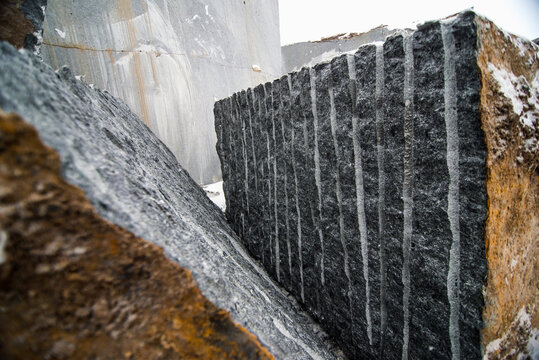Discovering the Rich Background and Lasting Practices of Granite Quarrying
As we base on the precipice of discovering the detailed tapestry of granite quarrying, a trip with time reveals not simply the physical act of extracting rock yet also the cultural and historical importance woven right into the really material of this technique. From the old beginnings that laid the foundation for contemporary quarrying strategies to the lasting practices that are forming the future of this market, each sculpt mark on granite surface areas tells a tale waiting to be uncovered (granite quarries in south africa). The heritage of granite quarrying stretches far past mere extraction; it is a testament to human resourcefulness, durability, and the enduring appeal of this stunning rock
Ancient Beginnings of Granite Quarrying
Going back to ancient people, the technique of quarrying granite has actually been an indispensable component of human background and building improvement. The earliest proof of granite quarrying go back to ancient Egypt, where substantial pyramids and elaborate sculptures were crafted from this sturdy stone. The Egyptians used primitive devices to remove granite blocks from quarries, showcasing the relevance of this material in their monumental building and constructions.
Progressing in background, the Greeks also made considerable payments to the quarrying of granite. The Greeks utilized granite in different building marvels, such as temples and sculptures, demonstrating their skill in shaping and carving this hardy stone. The Romans further refined the techniques of quarrying granite, using innovative devices like knives and hammers to remove and form granite for their famous structures.
Through the centuries, the practice of quarrying granite has evolved, with modern innovations improving effectiveness while preserving the timeless allure of this all-natural stone - granite quarries in south africa. From ancient civilizations to modern builders, the heritage of granite quarrying proceeds to shape our globe
Development of Quarrying Methods
The evolution of quarrying techniques has actually been marked by a continuous progression in the direction of higher performance and precision in extracting granite. From the rudimentary approaches utilized by our forefathers to the advanced technologies made use of in contemporary quarrying procedures, the market has actually gone through significant innovations. Early quarrying methods entailed hand-operated labor with basic tools such as knives, hammers, and wedges to draw out granite blocks from the planet. As worlds progressed, techniques like fire-setting and primitive nitroglycerins were introduced to promote the extraction procedure.
In more recent times, the development of equipment transformed the quarrying industry, allowing much faster removal rates and enhanced performance. Technologies such as ruby wire saws, high-pressure water jets, and pneumatic drills have ended up being typical in modern quarries, enabling for exact cutting and lowered waste. Improvements in computer-controlled tools and 3D modeling have actually maximized quarrying procedures, leading to marginal ecological effect and enhanced sustainability methods. As the demand for granite continues to rise, the evolution of quarrying techniques remains integral to conference sector requires effectively and sustainably.
Social Relevance of Granite
Granite holds a profound cultural value across various human beings as a result of its enduring presence in building masterpieces and prized monoliths. From the stunning pyramids of Egypt to the intricate makings of the Angkor Wat temple in Cambodia, granite has actually been a material of selection for revealing grandeur and long life in cultural heritage. In old Rome, granite columns adorned holy places and public buildings, representing strength and durability. The cultural relevance of granite extends beyond its physical attributes; it symbolizes resilience, stability, and eternity, making it a symbol of withstanding legacies and customs.

Lasting Practices in Quarrying
Amidst the rich history of granite quarrying and its cultural relevance exists a growing focus on lasting techniques within the industry. As environmental understanding and worries concerning source deficiency have actually heightened worldwide, the quarrying market has actually significantly embraced sustainable methods to decrease its effect on the atmosphere and bordering neighborhoods.

Additionally, recovery and recovery of quarry websites post-extraction are integral to sustainable methods. By bring back quarried locations to an all-natural or beneficial state, such as creating wildlife habitats or leisure areas, quarriers can balance out the ecological impact of their procedures and add favorably to the regional environment.
Heritage of Granite Quarrying
With a historic backdrop steeped in craftsmanship and industrial progress, what enduring impact has granite quarrying left on the landscape of modern culture? The heritage of granite quarrying goes beyond plain removal methods; it has shaped architectural wonders, city landscapes, and social heritage worldwide. The long lasting nature of granite has actually made it a favored choice for monuments, structures, and framework, standing as a testimony to the skill and artistry of quarry employees throughout generations.
Additionally, the economic impact of granite quarrying can not be forgotten. The market remains to provide employment possibility and drive local economies in regions where granite extraction is prevalent. It has likewise spurred technical improvements in quarrying strategies and devices, resulting in more reliable and sustainable practices.
In terms of sustainability, the tradition of granite quarrying consists of efforts to reduce ecological impacts with reclamation jobs and liable resource administration. By stabilizing economic rate of interests with ecological stewardship, the industry aims to make certain that future generations can continue to take advantage of this long-lasting natural deposit.
Final Thought
